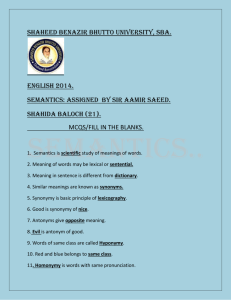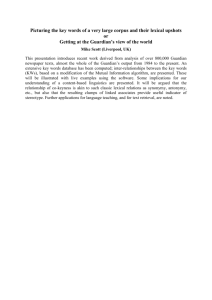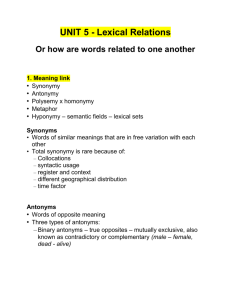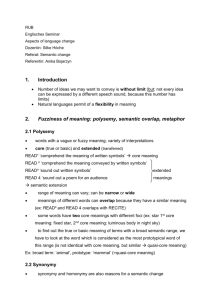Denotation: relationship of a single word/lexeme & a class of
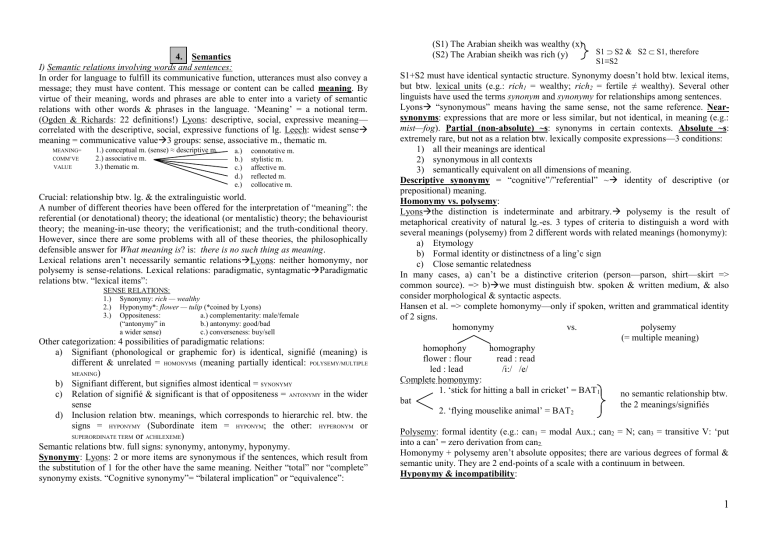
4. Semantics
I) Semantic relations involving words and sentences:
In order for language to fulfill its communicative function, utterances must also convey a message; they must have content. This message or content can be called meaning . By virtue of their meaning, words and phrases are able to enter into a variety of semantic relations with other words & phrases in the language. ‘Meaning’ = a notional term.
(Ogden & Richards: 22 definitions!) Lyons: descriptive, social, expressive meaning— correlated with the descriptive, social, expressive functions of lg. Leech: widest sense
meaning = communicative value
3 groups: sense, associative m., thematic m.
MEANING=
1.) conceptual m. (sense) ≈ descriptive m.
COMM’VE
2.) associative m.
VALUE
3.) thematic m. a.) connotative m. b.) stylistic m. c.) affective m. d.) reflected m. e.) collocative m.
Crucial: relationship btw. lg. & the extralinguistic world.
A number of different theories have been offered for the interpretation of “meaning”: the referential (or denotational) theory; the ideational (or mentalistic) theory; the behaviourist theory; the meaning-in-use theory; the verificationist; and the truth-conditional theory.
However, since there are some problems with all of these theories, the philosophically defensible answer for What meaning is ? is: there is no such thing as meaning .
Lexical relations aren’t necessarily semantic relations
Lyons: neither homonymy, nor polysemy is sense-relations. Lexical relations: paradigmatic, syntagmatic
Paradigmatic relations btw. “lexical items”:
SENSE RELATIONS:
1.) Synonymy: rich — wealthy
2.) Hyponymy*: flower — tulip (*coined by Lyons)
3.) Oppositeness:
(“antonymy” in a wider sense) a.) complementarity: male/female b.) antonymy: good/bad c.) converseness: buy/sell
Other categorization: 4 possibilities of paradigmatic relations: a) Signifiant (phonological or graphemic for) is identical, signifié (meaning) is different & unrelated =
HOMONYMS
(meaning partially identical:
POLYSEMY/MULTIPLE
MEANING
) b) Signifiant different, but signifies almost identical =
SYNONYMY c) Relation of signifié & significant is that of oppositeness =
ANTONYMY
in the wider sense d) Inclusion relation btw. meanings, which corresponds to hierarchic rel. btw. the signs =
HYPONYMY
(Subordinate item =
HYPONYM
; the other:
HYPERONYM
or
SUPERORDINATE TERM
or
ACHILEXEME
)
Semantic relations btw. full signs: synonymy, antonymy, hyponymy.
Synonymy : Lyons: 2 or more items are synonymous if the sentences, which result from the substitution of 1 for the other have the same meaning. Neither “total” nor “complete” synonymy exists. “Cognitive synonymy”= “bilateral implication” or “equivalence”:
(S1) The Arabian sheikh was wealthy (x)
(S2) The Arabian sheikh was rich (y)
S1
S2 & S2
S1, therefore
S1≡S2
S1+S2 must have identical syntactic structure. Synonymy doesn’t hold btw. lexical items, but btw. lexical units (e.g.: rich
1
= wealthy; rich
2
= fertile ≠ wealthy). Several other linguists have used the terms synonym and synonymy for relationships among sentences.
Lyons
“synonymous” means having the same sense, not the same reference. Nearsynonyms : expressions that are more or less similar, but not identical, in meaning (e.g.: mist—fog ). Partial (non-absolute) ~s : synonyms in certain contexts. Absolute ~s : extremely rare, but not as a relation btw. lexically composite expressions—3 conditions:
1) all their meanings are identical
2) synonymous in all contexts
3) semantically equivalent on all dimensions of meaning.
Descriptive synonymy = “cognitive”/”referential” ~
identity of descriptive (or prepositional) meaning.
Homonymy vs. polysemy :
Lyons
the distinction is indeterminate and arbitrary.
polysemy is the result of metaphorical creativity of natural lg.-es. 3 types of criteria to distinguish a word with several meanings (polysemy) from 2 different words with related meanings (homonymy): a) Etymology b) Formal identity or distinctness of a ling’c sign c) Close semantic relatedness
In many cases, a) can’t be a distinctive criterion (person—parson, shirt—skirt => common source). => b)
we must distinguish btw. spoken & written medium, & also consider morphological & syntactic aspects.
Hansen et al. => complete homonymy—only if spoken, written and grammatical identity of 2 signs. homonymy vs. polysemy
(= multiple meaning)
homophony homography
flower : flour read : read
led : lead /i:/ /e/
Complete homonymy:
1. ‘stick for hitting a ball in cricket’ = BAT
1 bat
2. ‘flying mouselike animal’ = BAT
2 no semantic relationship btw. the 2 meanings/signifiés
Polysemy: formal identity (e.g.: can
1
= modal Aux.; can
2
= N; can
3
= transitive V: ‘put into a can’ = zero derivation from can
2.
Homonymy + polysemy aren’t absolute opposites; there are various degrees of formal & semantic unity. They are 2 end-points of a scale with a continuum in between.
Hyponymy & incompatibility :
1
Lyons characterizes hyponymy as the most fundamental subordination or superordination. The subordinate term (= hyponym ) necessarily implies the superordinate one, but not vice versa. The latter is called hyperonym (or archilexeme ). Hyponyms which are on the same level of the hierarchy = co-hyponyms .
Unilateral (=asymmetrical) implication flower superordinate (term) = archilexeme
tulip ↔ flower ↔ rose (co-) hyponyms
HYPONYMY
“proper hyponymy”
Hyponymy is a relation btw. lexical units, not lexemes. Incompatibility (Lyons): defined on the basis of the logical contradictoriness btw. 2 sentences. If S1 explicitly or implicitly denies another sentence S2 & the 2 sentences only differ in that one has the lexical item x
& the other has y in the same syntactic position, then x & y are incompatible. All those co-hyponyms are incompatible, which belong to the same dimension—e.g.: COLOUR, SEX,
AGE, etc. This sense-relation is also a matter of lexical units.
Complementarity, antonymy, converseness :
Lyons calls the traditional rel. of antonymy ‘oppositeness of meaning’ & distinguishes 3 different types of oppositeness:
1.) Complementarity: ( male—female; single—married ) The denial of the one implies the assertion of the other & vice versa. The def. of this sense-relation is therefore based on logical implication combined with negation. E.g.: John isn’t married —implies: John is single ; John is married —implies: J. isn’t single .
2.) Antonymy: based on different logical relationships—e.g.: good/bad, big/small, high/low, etc. The assertion containing one member does imply the negation of the other, but not necessarily vice versa. J. is good ~ J. is not bad ; BUT: J. isn’t good (↔) J. is bad .
3.) Converseness: derives from symbolic logic, where converse denotes an equivalent mirror-image relation, or function, in which the order of the arguments is reversed (e.g.: husband/wife, doctor/patient, teacher/pupil). The sentences imply each other, & have the same meaning—e.g.: J. bought the car from Bill = Bill sold the car to J. (
3-place predicate)
Utterance : minimal (spoken or written) texts, products of Chomskyan ‘performance’; signals which are transmitted from speaker to hearer along some appropriate channel.
Non-sentences : not sentences ‘cos they’re grammatically incorrect, incomplete, elliptical.
Sentence-meaning : context-independent (utterance-meaning is not); always gr’l, has a potential for being used, part of the sys., has tense, abstract. Utterance : can be ungr’l, part of use, often incomplete, matter of performance, may be shorter or longer than sentence, concrete.
Like words, sentences have meanings that can be analyzed in terms of their relation to other meanings. There are 3 such relations: paraphrase , entailment , and contradiction .
2 sentences that have the same meaning are said to be paraphrases of each other. (E.g.:
The police chased the burglar . ~ The burglar was chased by the police .) It would be impossible for one sentence in any pair to be true without the other also being true.
Sentences, whose meanings are related to each other in this way, are said to have the same truth conditions. One may notice, however, that there are subtle differences in emphasis btw. the sentences in the pairs.
Entailment: a relation in which the truth of one sentence necessarily implies the truth of another. The ~ relation, f.i., btw. Paul bought a car from Sue and Sue sold a car to Paul is mutual, since the truth of either sentence guarantees the truth of the other. In some cases however, entailment is asymmetrical: Robin is a man — Robin is human
the 1 st sentence entails the 2 nd , but not necessarily vice versa.
Sometimes, it turns out that if 1 sentence is true, then another sentence must be false.
E.g.: Charles is a bachelor. Charles is married. => When 2 sentences cannot both be true, we say that there is contradiction. Contradictions are necessarily false by virtue of logical form ( It’s raining and it’s not raining .) Tautologies are necessarily true by virtue of logical form ( Either it is raining, or it is not raining .) Contradictions & tautologies: subclass of logical truths.
II) Meaning:
Lyons introduces the distinction btw. reference + denotation; Coseriu differentiates signification (Bedeutung) & designation (Bezeichung).
Denotation : relationship of a single word/lexeme & a class of obj.-s. According to
Lyons, ~ holds btw. a lexeme + a class of extraling’c obj.-s — invariant & independent of context of utterance; ~ is intrinsically connected with reference. Not pure, word-level category, set of potential referents, not context-dependent, extension.
Connotation : the set of associations that a word’s use can evoke (e.g.: winter
in the
North: snow, bitter cold, short evenings, etc.
these are the connotations, but not the meaning of winter!) Leech
~ is a subclass of his associative meaning: inherent property of lexical items, additional properties of a lexeme:
Regional, temporal, social connotations
3 main classes of connotations: a) Stylistic — e.g.: bloke, bugger, swain (high—e.g. formal; low—e.g. colloquial) b) Expressive—e.g.: niggard, bastard (derogatory; taboo) c) Regional—e.g.: elevator, streetcar, truck
Sense : each such relation that holds btw., for instance, ‘dog’ & other expressions of the same lg. sys. May be identified as one of its sense-relations . Sense of an expression: a set, or network, of sense-relations that hold btw. it & other expressions of the same lg.
Sense: pure
internal to the lg. sys., different lg.-s have different numbers of terms for the same segment of reality (e.g.: colour terms), word-level category, intension.
Reference : a well-known approach to semantics attempts to equate a word’s meaning with the entities to which it refers—its referents. Reference: variable & utterancedependent; relationship of extralinguistic obj. to meaning ( morning star ↔ evening star
same referent), i.e., a relationship btw. an expression & what it stands for on particular occasions of its utterance—depends on the concrete utterance. Not pure, not word- but phrase-level category ( the book ), heavily context-dependent, identifies some element of reality, doesn’t have to be true, opacity ( J. wants to marry the nastiest girl in town.
opaque: wants to find & marry that girl, transparent: he already knows her, wants
2
to marry her), intension. Lexemes don’t have ~, but can be used as referring expressions.
There are some problems with this theory: 1) there’s a problem with words such as
‘unicorn’ or ‘dragon,’ which have no referents in the real world even though they are far from being meaningless. Lexemes and larger expressions have denotation & sense; ref. is a property of ‘referring expressions.’ The impossibility of equating a word’s meaning with its referents has led to a distinction btw. extension & intension . These are 2 different types of inclusion. Whereas a word’s extension corresponds to the set of entities that it pick out in the world, a class of things to which a term may be applied (class of extralinguistic referents denoted by a sign included in the class of referents denoted by another sign: animal>mosquito, horse, elephant ), its intension corresponds to its inherent sense, the concept that it evokes, i.e. a set of properties determining the applicability of a term (= meaning [sense] inclusion
meaning of 1 item is included in another: horse>animal ).
In the extralinguistic world, there are no clear-cut borderlines or distinctions, lines btw. categories are only drawn in a specific lg. E.g.: color terms
It.: azurro, blu = Eng.: blue .
2 lexical items in one lg. converge in a single lexical item in another = convergence .
from the point o view of the other lg. it’s divergence .
One suggestion is that word meaning (intensions) correspond to mental images .
Unfortunately, this idea also encounters problems
hard to conceive a mental image for words like “nitrogen,” 522, 101, “if,” “very,” etc.; there seems to be no mental image for the meaning of the word “dog” that could be general enough to include Chihuahuas &
Irish wolfhounds, yet still exclude foxes + wolves.
Still another approach o meaning tries to equate a word’s intension with an abstract concept consisting of smaller components called semantic features . The componential analysis is especially effective when it comes to representing similarities & differences among words with related meanings. E.g.: man:
+HUMAN boy:
+HUMAN
+MALE +MALE
+ADULT -ADULT
An obvious advantage of this approach is that I allows us to group entities into natural classes.
Denotation & reference establish link btw. the lg. sys. & the world; sense & reference represent 2 extremes denotation stands somewhere in the middle.
From the preceding survey, it seems that meaning must be sg. That exists in the mind rather than in the world and that it must be more abstract than pictures & more complex features. John Locke suggested that words are ‘marks of ideas in the mind.’ This proposal is typical of a wide range of traditional & modern approaches to semantics, all of which try to relate meaning to mental concepts of some sort.
III) Syntactic structure and semantic interpretation:
The Principle of Compositionality : The meaning of a sentence is determined by the meaning of its component parts and the manner in which they are arranged in syntactic structure
meaning of a composite expression is a function of the meanings of its composite expressions (Frege)
applies to sense & denotation. Lexeme : lexically simple expression; lexically composite expressions : constructed by means of gr’l rules of the lg.
(E.g.: pass muster = lexeme; pass an examination = composite expr.) Some sentences are ambiguous ‘cos their component words can be arranged into phrases in more than 1 way.
Structural ambiguity , e.g.: old men and women
’old’=a property of both or only of men alone:
NP or: NP
A N NP N’
N’ A N Con. N
old men and women
N Con. N
old men and women
(Further examples: Nicole saw the people with binoculars ; French history teacher )
Lexical ambiguity is the result of homophony or polysemy.
Part of semantic interpretation involves determining the roles that the referents of NPs play in the situation described by sentences. The term thematic role or semantic role is used to describe the part played by a particular entity in an event. ( The senator
[Agent] sent the lobster
[Theme] from Maine
[Source] to Nebraska
[Goal]
.) Agent : the entity that deliberately performs an action. Theme : the entity undergoing a change of state or transfer. Source : the starting point for a transfer. Goal : the end point for a transfer.
Some additional thematic roles: The astronomer
[Experiencer] saw the comet
[Stimulus] with a new telescope
[Instrument] at the observatory
[Location].
Experiencer : the entity perceiving sg.
Stimulus : the entity perceived. Instrument : the entity used to carry out an action.
Location : the place at which an entity or action is located.
Thematic roles originate in word meaning. The roles are then assigned to NPs based on their position in syntactic structure, with each NP receiving 1 and only 1 role.
PP PP
P NP P NP
from
<Source> Maine
to
<Goal> Nebraska
Matters are slightly more complicated in the case of Vs. Here we must distinguish btw. the Theme role, which is assigned to the V’s complement, and the Agent role, which is assigned to its subject.
A V assigns a Theme role (if it has one) to its complement NP, and an Agent role (if it has one) to its subject NP.
S
NP NP
NP
Det. N V Det. N
The campers boiled the water
<Agent, Theme>
The category of pronouns includes words such as he, she, himself , & herself . These words are characterized by the fact that their interpretation can be determined by another element in the same sentence. This other element is called the antecedent .
3
Jim’s new car cost him a lot of money .
’him’ can have the same referent as the NP Jim, or can refer to sy else not mentioned in the sentence => pronominal .
Jim hurt himself .
’himself’ has the same referent as Jim => reflexive pronoun .
A reflexive pronoun must have an antecedent in the smallest S containing it.
Constraints on the interpretation of reflexives: Principle A : A reflexive pronoun must have an antecedent that c-commands it. Principle B : A pronominal must not have an antecedent that c-commands it. (C-command: a node A c-commands another node B, iff. the 1 st category above A contains B.)
IV) Fuzzy concepts, prototypes and basic level terms:
Categorization: arranging things, which have 1 or more common features, into classes or categories. (Eleanor Rosch
prototype theory
birds)
Underlying the use of words & sentences to express meaning in human language is a conceptual system capable of organizing and classifying every imaginable aspect of our experience. Some concepts may have precise, clear-cut boundaries, but not all concepts are straightforward. Some notions, then, have no clear-cut boundaries, we call these fuzzy concepts (e.g.: rich, tall, old , etc.). A 2 nd important fact about concepts is that their members can be graded in terms of their typicality (e.g.: bird
robins, magpies: intuitively better examples than hummingbirds, ostriches or penguins). Examples like these suggest that concepts have an internal structure, with the best or prototypical exemplars close to the core and less typical members arranged in successively more peripheral regions.
Labov
experiments to discover denotative use of container terms like cup, bowl, glass , etc. => culture-dependent categorization of reality in natural languages. => concept of
‘prototype’ = central/typical elements of a category vs. ‘periphery’.
Basic level terms : most important word, culture-dependent; a family of events, objects, patterns, emotions or social relations that are cognitively basic. The idea of BLTs can’t be separated from the concept of the gestalt : a functional unit that’s more than the collection of its parts; we usually interact with it through its parts. BLT—e.g.: pen
psychologically somewhere in the middle of a category, used in 1 st naming the object, 1 st learned by the child, in English 1 of the shortest, commonest words, specific interaction—gestalt perception. Also typical: kinesthetic image schemas
basic relationships, learned through bodily interaction with the environment ( up—down , in— out , source—path—goal , etc.)
V) Metaphor:
The concepts expressed through language aren’t isolated from each other. Rather, they make up a giant network, with many interconnections and associations among the various subparts. A good example of these connections involves metaphor , the understanding of one concept in terms of another. It has a prominent place in the conceptual system shared by all human beings. A simple example of this involves time, which we analyze metaphorically by treating it as if it were a concrete commodity. (E.g.: You’re wasting my time. He’s living on borrowed time ; etc.) However, there’s apparently no objective, inherent similarity btw. time and commodities such as gold or money. What brings these concepts together is the perception , based in part on culture and in part on the subjective feeling that the passing of time is like the passage of vulnerable commodities from one head to another.
Another very prevalent metaphor in our language involves the use of words that are primarily associated with spatial orientation to talk about physical & psychological states.
(E.g.: physically down
lethargy, inactivity, etc.: I’m feeling down. He fell into depression. He’s feeling low.
; physically up
energy, movement). => Time: understood in terms of a commodity metaphor, health & happiness in terms of a spatial metaphor.
VI) The lexicalisation and grammaticalisation of concepts:
At present there’s no reason to believe that human beings in different linguistic communities have different conceptual system. But there’s ample evidence that languages can differ from each other in terms of how they express concepts. (E.g.: snow
in
Eskimo: different expressions, e.g. for ‘snow on the ground,’ ‘falling snow,’ ‘drifting snow,’ etc. These types of differences involve lexicalisation , the process whereby concepts are encoded in the words of a language. Some lexicalisations may correlate with cultural factors. All lg.-es have words that can describe motion through space ( come, go, move , etc.). However, there are systematic differences in terms of how languages express motion & the concepts related to it. (E.g.: roll, slid, limp, swirl
express both the concept of motion and the manner in which the motion occurs.) Romance lg.-es cannot express motion events in this way, the motion & its manner have to be expressed separately. Amerindian lg. Atsugwei, on the other hand, can express both motion & the type of thing that moves.
Within particular semantic domains, thus, there may be a small universal set of concepts and a small set of opinions for how these concepts can be combined for purposes of lexicalisation. Of the infinitely large set of concepts expressible in human lg., a relatively small subset enjoys a special status. These are the concepts that are lexicalized as affixes
& nonlexical (functional) categories. Concepts that are expressed as affixes or nonlexical categories are said to have been grammaticalized . Some concepts tend to be highly grammaticalizable, in that, most, if not all, lg.-es lexicalize them as affixes or special nonlexical categories. (E.g.: negation, conjunction
grammaticalized concepts in all languages). Contrasts involving singular vs. plural, & past vs. non-past are encoded by special affixes in many lg.-es, but not in all.
VII) The Sapir-Whorf hypothesis:
As we examine the way in which words + structures are used to express meaning, it’s natural to wonder about the possibility that language might play a role in shaping how we think. It has been suggested that the particular language we speak shapes the way in which we think & perceive the world. The best-known & most influential version of this idea has come to be known as the Sapir-Whorf Hypothesis in honor of Edward Sapir &
Benjamin Lee Whorf, the 2 linguists who articulated it most clearly. 2 types of linguistic phenomena that are commonly cited in support of the hypothesis: 1) cross-linguistic differences in vocabulary; 2) variation in the type of grammatical contrasts a language encodes. (E.g.: 1)
Eskimo & Arabic allow their speakers to make perceptual distinctions pertaining to snow & sand that Eng. speakers cannot.)
4
Language is shaped by the need to adapt to the cultural and physical environment. If a lg. has a large vocabulary in a particular area, it is ‘cos subtle distinctions of that type are important to the speakers.
Whorf concentrated on the expression of grammatical contrasts. He attempted to link the apparent lack of tens contrasts in Hopi (an Amerindian lg., spoken in the Am. Southwest) with different cultural attitudes toward time and the future. Time for the Hopi doesn’t consist of the passage of countable units (like days) but rather the successive reappearance of the same entity. Whorf believed that this is reflected in the Hopi belief that the future is best dealt with by working on the present situation (which will return as the future). But there, again, innumerable problems arise. Whorf was mistaken in his belief that Hopi doesn’t have tense. Moreover, even if there were no tense contrasts in
Hopi or if they were radically different from those found in English, it’s unlikely that they could be correlated with speakers’ attitudes towards time.
There have been various attempts to verify the Sapir-Whorf Hypothesis by experimental means. The most famous of these experiments was conducted in 1958. The basic idea was to determine the effect of English and Navaho on the perception of color, shape & size. In
Navaho, Vs expressing handling actions vary in form depending on the shape of the object being handled. There’s no such contrast in Eng. Thus it was thought that children speaking the 2 lg.-es might group objects in different ways. An experiment was designed to test this:
Children => rope & stick + new object
which of the pair went best with the new object?
Navaho: reflect the classification imposed by the V sys.; Eng.: very similar to those of monolingual speakers of Navaho. => this isn’t the result predicted by the S-W
Hypothesis. This is not to say that languages don’t represent reality in different ways.
What is in doubt is whether the differences in the linguistic description of reality reflect deeper, lg.-induced differences in patterns of thought or perception.
5

